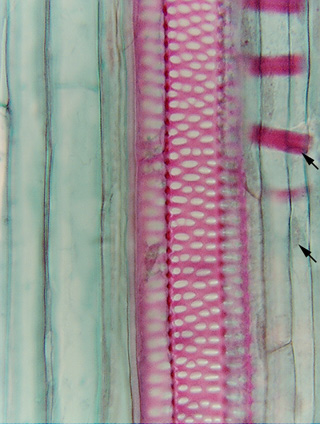Up
Primary xylem
Oak wood
Leaf vein
Vein ends
Bean seed
Pine tracheids, xs
Fern TE, xs
Fern, TE, mag
Annular walls
Annular, stretched
Annular, narrow
Scalariform walls
Scalar., narrow
CBP, pine
CBP, dicot
CBP, irregular
Contact faces
Pits, side view
CBP, pine, xs
CBP,angio, xs
CBP, fern, xs
Contact face, xs
Simple perf. plate 1
Simple perf. plate 2
Pitted perf. plate
Perf. plate & helix
Perf. plate, face
Perf. plate, mag
Perf. plate, section
Perf. plate rim
Perf. plate & wall
Scalariform Per plate
Primary xylem
Vessel sizes
Fern TE
Pine needle
VE precursor, ls
Protoxylem
9 Contact faces
VE precursor, xs
Precursor 2
Torn vessel
Torn vessel 2
| |
 Fig.
7.2-8. Longitudinal section of vessel element of corn (Zea mays).
Corn is a flowering plant (as opposed to a conifer), so its circular bordered
pits are small, like those of American hornbeam in Fig. 7.2-7, rather than large
like those of pine in Fig. 7.2-6. Notice that these circular bordered pits are
not quite as orderly as the ones in American hornbeam; they are of
various sizes, some quite a bit larger than others, and they do not form a neat
hexagonal arrangement. The regularity of pitting is variable – in some
species, scalariform pits or circular bordered pits are remarkably regular; in
others, they are almost haphazard. Fig.
7.2-8. Longitudinal section of vessel element of corn (Zea mays).
Corn is a flowering plant (as opposed to a conifer), so its circular bordered
pits are small, like those of American hornbeam in Fig. 7.2-7, rather than large
like those of pine in Fig. 7.2-6. Notice that these circular bordered pits are
not quite as orderly as the ones in American hornbeam; they are of
various sizes, some quite a bit larger than others, and they do not form a neat
hexagonal arrangement. The regularity of pitting is variable – in some
species, scalariform pits or circular bordered pits are remarkably regular; in
others, they are almost haphazard.
The four thick red bands on the right are pieces of annual secondary wall
on an adjacent vessel element. They are slightly out of focus, indicating that
the cell they and their associated cell are lying slightly above or below the
pitted wall. Notice that there is a nucleus at the lower arrow; it is lying in
(or beside) a long cell whose end wall is visible at the upper arrow. Because we
can see the end wall, it is probably lying above the annular wall; if it were
below it, the annular wall is so dense it would probably hide the end wall.
|
 Fig.
7.2-8. Longitudinal section of vessel element of corn (Zea mays).
Corn is a flowering plant (as opposed to a conifer), so its circular bordered
pits are small, like those of American hornbeam in Fig. 7.2-7, rather than large
like those of pine in Fig. 7.2-6. Notice that these circular bordered pits are
not quite as orderly as the ones in American hornbeam; they are of
various sizes, some quite a bit larger than others, and they do not form a neat
hexagonal arrangement. The regularity of pitting is variable – in some
species, scalariform pits or circular bordered pits are remarkably regular; in
others, they are almost haphazard.
Fig.
7.2-8. Longitudinal section of vessel element of corn (Zea mays).
Corn is a flowering plant (as opposed to a conifer), so its circular bordered
pits are small, like those of American hornbeam in Fig. 7.2-7, rather than large
like those of pine in Fig. 7.2-6. Notice that these circular bordered pits are
not quite as orderly as the ones in American hornbeam; they are of
various sizes, some quite a bit larger than others, and they do not form a neat
hexagonal arrangement. The regularity of pitting is variable – in some
species, scalariform pits or circular bordered pits are remarkably regular; in
others, they are almost haphazard.